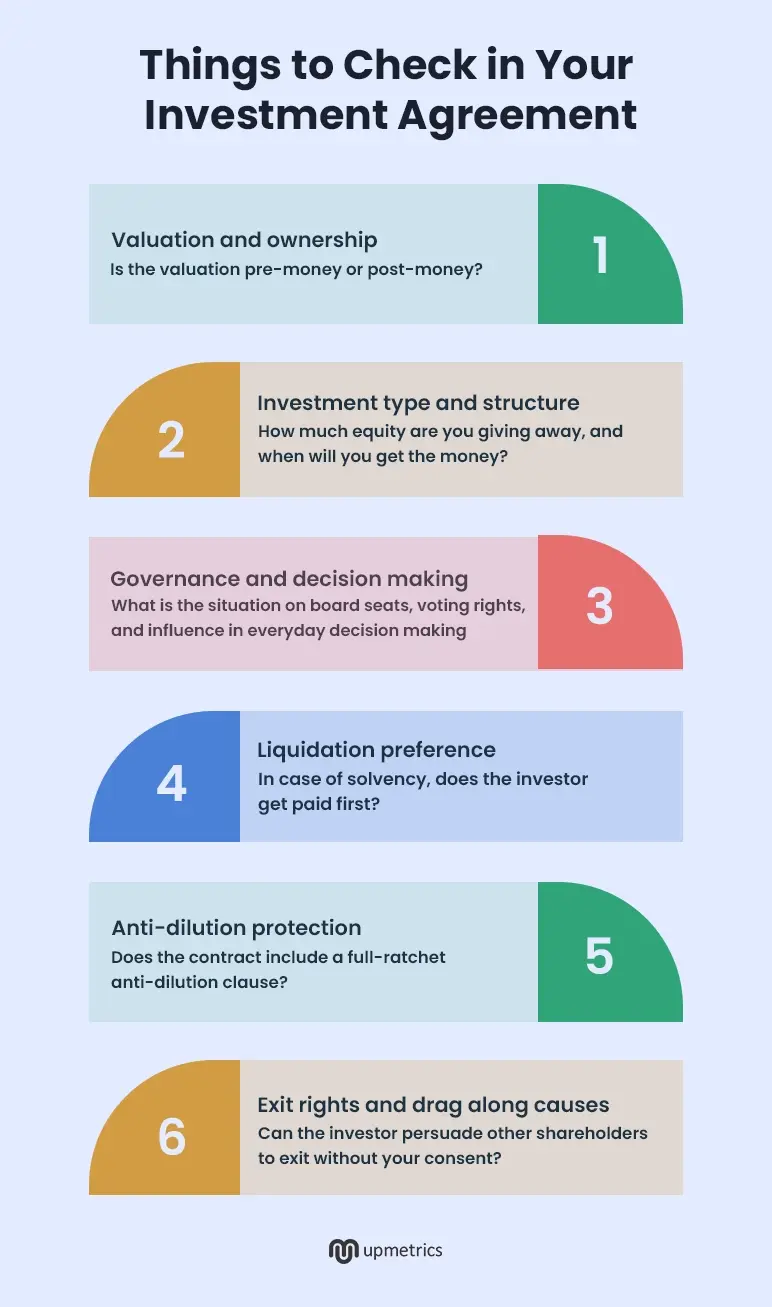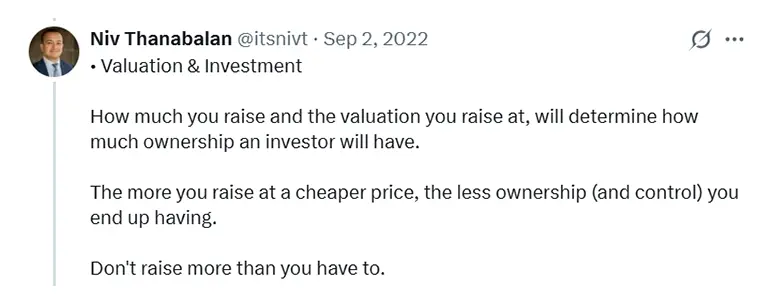Ever watched a Shark Tank clip and thought, “Damn, they just bagged $10 million like it was nothing”?
The high-fives, the excitement—it’s hard not to get pulled in.
But here’s what those shows don’t show you: The part where the deal actually gets closed.
According to Forbes, nearly 43% of deals fall apart during the contract phase. And about 30% of them change entirely by the time they’re legally executed.
Well, not surprising.
There’s a saying in the investor’s world “You name the price, I’ll name the terms.”
And that’s where things shift.
Valuation might sound great, but the real decisions sit in the terms—how equity gets divided, who’s on the board, what happens in a down round, and who decides when it’s time to sell.
Each of these things is mentioned in your investor contract for small business. We’ll show you what to look out for and how.
What is an investor contract?
An investor contract is a legal document that clearly outlines the terms under which an investor puts money into your business. It’s a binding agreement that defines ownership, control, investment structure, dilution protection, governance rights, and what happens during an exit or future funding rounds.
6 things to check in your business investor agreement

Before signing your investment agreement, make sure you understand what’s at stake and what happens in case of dilution, future funding rounds, exit, and non-compliance.
Here are a couple of things you should check in your investment agreement.
1. Valuation and ownership
How much is your business worth?
Think of it as a price tag investors put on your company after weighing your product, market, team, traction, and future potential.
This valuation sets the price investors will pay for a piece of your business.
Let’s say your company is valued at $1 million and an investor puts in $250k. This may sound exciting. But before agreeing to this, there’s one important question you should be asking.
Is this $1 million pre-money or post-money valuation?
Let me explain,
| Term | What it means | Example |
|---|---|---|
| Pre-money | Valuation of your business before injecting investor’s money | A $1 million pre-money valuation becomes $1.25M after the investor’s $250K. Here, an investor gets 20% of business equity, i.e., $250K of $1.25M |
| Post-money | Valuation of your business after injecting investor’s money | $1 million post-money valuation includes investors’ $250K. Here, an investor gets 25% of business equity, i.e., $250K of $1M |
Similarly, check if an investor requires you to expand the employee stock option pool before investment. If this option pool is made on pre-money valuation, the extra dilution comes out of your pocket.
Meaning, if your equity, taking into account the investor’s equity, is 80%, creating a 15% option pool will bring down your equity to 65%.
Is there a problem with such valuation? Not really.
It’s just something you should know before signing the contract.
If the contract doesn’t spell out these terms clearly, ask. In fact, ask repeatedly till you gain clarity on this.

Niv Thanabalan, Founder and Business Growth Specialist, said you’re giving away a piece of your business (literally) when an investor invests in your business. Don’t make a mistake of raising more than you need or giving away more equity just because the money sounded too good.
2. Investment type and structure
When an investor agrees to fund your business, they don’t always hand over a lump sum. And they don’t always walk away with shares either.
Sometimes, it’s equity. Sometimes, it’s debt.
Sometimes, the money comes all at once. And sometimes, its released in phases upon meeting certain conditions.
This is what we mean when we say look out for investment type and structure. Because even when the valuation may sound good, the structure and way the money is released may or may not favor you.
Well, let’s break down the four most common investment types at the early stages—and exactly what you should be watching for.
| Type of investment | What it means | What to look for? |
|---|---|---|
| Equity investment | Investor buys shares of your business, making them partial owners |
Are they taking common shares or preferred shares? Common shares: Gets you equal footing as an investor in terms of voting, decision-making, and profits (of course, proportionate to shares) Preferred shares: Allows investors to dictate their own terms for voting rights, liquidation, board seats, and anti-dilution. |
| Debt financing | It’s just a loan from an investor that needs to be repaid with interest, regardless of profit or loss. Investor gets no share in equity. | • What’s the interest rate? • When do payments start? • Is it secured (backed by assets)? • Is it convertible loan in case of default? • Any penalties, equity kickers, or conversion clauses? |
| Convertible note | It’s a loan that turns into equity in a future round. No fixed ownership now, but they’ll own a chunk later—at a discount. | • What’s the discount? • Is there interest? • When does it convert—and can they demand early repayment? • What is the valuation cap? |
| SAFE (simple agreement for future equity) | It’s like a convertible note without an interest or maturity date. It converts to shares in the next round, often at a discount or capped valuation. | • Does it include pro-rata rights or a repurchase right? • What is the valuation cap? It will set prices for future rounds • Is there an MFN (most-favored nation) clause? This allows them to claim better rights terms than other investors |
Also refer to how the investor would release the capital. More often than not, investors release the capital in tranches. That is, they would release parts of capital as and when certain revenues or milestones are met.
This is a common practice. However, it’s important to have the milestones and pre-conditions clearly defined in the contract.
After all, how capital is released will greatly influence the way you put a certain amount to use.
3. Governance and decision-making
With equity, you are also giving investors certain rights in decision-making and governing your company. However, to what extent?
The agreement defines that.
In your agreement, look for the section that lays out investor rights. Sometimes, it’s buried in board setup or voting clauses.
Look out for these governing factors in your agreement. They aren’t necessarily against you, but will tell you the extent of the investor’s involvement in your business.
| Governing power | What does it mean? |
|---|---|
| Board seat | They get a seat on board and a say in every key strategic decision—fundraising, hiring, budgets, exits |
| Veto rights | Power to block major actions like raising funds or selling the company, even with minority ownership |
| Reserved matters | List of decisions from hiring to purchase that need investors’ approval |
| Quorum requirement | Board decisions can’t be made unless the investor or their rep is present, giving them passive blocking power |
| Founder roles | Clearly defined duties and responsibilities of a founder. Also defines what happens in case the owner leaves before a certain period |
Most of these terms may seem harmless until you require an investor’s permission to make even a small hiring decision. Every added layer of permission can slow you down, especially when you are planning to grow rapidly.
4. Liquidation preferences
This clause decides who gets paid first—and how much—when your company exits.
If you’re into startups, you would have seen headlines like:
“Startup acquired for $10 million”
Sounds like a win. But how much of that actually ends up in the founder’s pocket?
Often, not much.
You see, when the company is acquired or sold, the investors get paid back first because they hold preferred shares—and preferred comes with perks. One of those perks is liquidation preference.
If investors have set a 2x liquidity preference, they don’t just get their original investment back—they get twice that amount before anyone else sees a dollar, i.e., $6 million on a $3 million investment.
If it’s 3x, they get triple the amount they invested in the business.
And if the investment is structured as participating, they don’t stop at getting their capital back—they also claim a cut of the remaining pie.
Is it wrong? Maybe. It’s a sneaky clause that lets investors get the best of their investment. And sometimes, it’s necessary so that you don’t short-sell your business before its time.
5. Anti-dilution protections
Dilution occurs whenever new (more) shares are issued (created). This increase in shares makes the pie bigger and shrinks the slice owned by existing shareholders.
To simplify, let’s say investors own 1,000 out of 10,000 shares—10% of the company. Now, the company issues 5,000 new shares to investors(new party) to raise more money.
This increases the total number of shares from 10,000 to 15,000, and just like that investor’s 1,000 shares now represent 6.6% (1000 of 15,000) of the company’s equity, not 10%. This reduction in equity is called dilution.
It’s normal and it happens with every business. But more often than not, investors aren’t the ones suffering from dilution.
Thanks to a small but ironclad clause buried in your agreement—anti-dilution protection—they stay protected while your stake takes the hit.

Walker Deibel, author of Buy then Build
Accordingly, this clause activates when your next valuation is lower than the last one. It comes in one of these two common forms. Let’s check them:
| Type | What does it mean | Example |
|---|---|---|
| Full Ratchet | Reprices investor’s shares to match the new lower price | First round: 10,000 shares issued at $10 each Down round: $5 each shareUnder full ratchet, the investor’s original $100,000 is treated as if it was invested at $5/share.So instead of holding 10,000 shares (at $10/share), they now hold 20,000 shares (as if they bought at $5/share). |
| Partial ratchet | Adjusts share price based on both new price and new shares issued | Here also, the shares are readjusted—but instead of being recalculated to match the new lower price (like in full ratchet), they’re adjusted to a weighted price. |
Now, anti-dilution is necessary for investors. And it’s not necessarily a bad thing as long as it occurs in conjunction with an increased valuation.
6. Exit rights and drag-along clauses
Down the line, do you plan to sell the company in five years? Go public? Get acquired by a bigger player?
Investors rarely invest without seeing an exit plan.
They want to know how and when they’ll get their money back. That’s why exit rights exist in your agreement. They give investors a say in how a future sale plays out.
And sometimes, with the right clause, they can even force the exit at their will.
Look out for something called drag-along rights in your agreement.
This clause allows majority shareholders, usually led by investors, to compel everyone else, including you, to sell when investors want out.
The timing could be wrong. The price could be too low. It could wipe out your equity. But you get zero say in when your company gets sold. And if liquidation preferences sit above your payout in the stack, you might not be left with much.
Those are the many, if not all, things you should be aware of in your investor contract for a small business.
Tips to Negotiate an Investor Contract That Favors You
Remember, convincing an investor to fund you is just the first leg of the challenge. The hard part starts after the handshake.
The road between getting a yes and actually closing the deal is full of fine print. And that’s where most deals fall apart.
Well, here are a few tips to help you negotiate a contract that actually favors you:
- Know what you actually care about: You can’t fight every clause, so just focus on the ones that matter and offer leverage—ownership, control, dilution, and exit
- Push for a board seat balance: Make sure you’re not outvoted on your own company—know who else would be on board before agreeing
- Don’t accept full-ratchet anti-dilution: You most probably can’t fight anti-dilution, but you sure can push for weighted dilution that fits your terms
- Set liquidation preference to 1x: Especially if yours is a pre-seed venture with moderate risks
- Define founder roles and responsibilities: Set clear boundaries—who’s the CEO, what happens if someone wants to leave, and how equity vests
- Push for capital clarity: If funding is coming in tranches, make sure the goals tied to each release are clear and reasonable
And this final one deserves a special note and utmost consideration.
Get yourself a lawyer
Not just any lawyer, but someone who has seen and executed hundreds of venture deals.
Even when you know what you should look for, the legal terminologies and language will baffle you.
Agreements aren’t simple documents. They’re 30 pages of jargon designed to make your eyes glaze over.
A lawyer will make sure you’re not walking into something you’ll regret or at least that you understand clearly where your business stands with this investment.
Prepare for an Investment with Upmetrics
Investor contracts can be overwhelming. And while you can’t avoid the legal stuff, you can absolutely be prepared for it.
Hire a lawyer. Educate yourself. Know your worth.
And most importantly, learn to negotiate what’s right for you.
If you’re raising capital or preparing for investor conversations, it’s important to understand your business in and out. Much of the convincing gets easier when you have crystal clarity about where your business stands, what its strengths are, and where it can venture strategically in the next 5 years.
Upmetrics helps you get that clarity by guiding you to build forecasts, an undeniably strong business plan, and an attention-grabbing pitch deck. It gives you the clarity to stand your ground when it’s time to talk terms.



